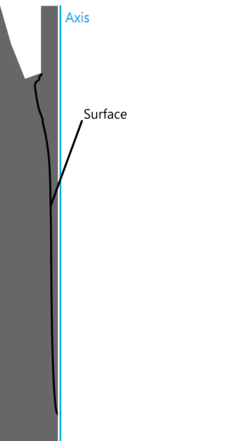-
-
July 2, 2021 at 12:23 pm
aitor.amatriain
SubscriberI am simulating an axisymmetric problem. I have defined an iso-surface of interest,
July 2, 2021 at 3:15 pmRob
Forum ModeratorIn 2d we assume the domain is 1m thick (I advise against changing the reference depth) and in 2d-axi it's either PI or 2PI, but I can never remember which. As your surface is at different radial positions I'd check which it is using one of the other boundaries.
July 5, 2021 at 7:07 amaitor.amatriain
SubscriberHello Rob Thank you for your answer. I understand that the area of the surface is computed by means of the usual formula for revolution surface, but I still have a doubt in terms of the area of the cells.
In a 3D mesh, all cells in contact with a surface have a well defined area. However, in a 2D mesh and an additional assumption has to be done. How is the area of the cells in contact with the revolution surface computed? ANSYS Fluent considers that each of the cells covers all angles from 0 to 2*pi?
Thank you Aitor
July 5, 2021 at 9:07 amRob
Forum ModeratorAs you suspect we assume each cell is PI or 2PI radians (if you find the documentation post the link in here for future reference), so represents an annular volume. Remember your cell has a volume, and the surface (boundary) area is that of the sector. So the area may be PI r^2 (assuming it's circular) or PI d length in the event it's an annular surface.
July 5, 2021 at 11:20 amaitor.amatriain
SubscriberThank you As far as I am concerned, this issue related to the cell area and volume in 2D axisymmetric problems affects to all the Chapter 30
Chapter 30: Reporting Alphanumeric Data (ansys.com)
It would be interesting for other users to include a warning/note mentioning that cells are assumed to cover all the circumference.
July 5, 2021 at 12:47 pmRob
Forum ModeratorLike this one? https://ansyshelp.ansys.com/account/Secured?returnurl=/Views/Secured/corp/v211/en/flu_ug/flu_ug_sec_report_conventions.html I knew it was somewhere!
July 6, 2021 at 6:42 amaitor.amatriain
SubscriberYes! Thank you!
July 6, 2021 at 9:24 amAmine Ben Hadj Ali
Ansys EmployeeWelcome!
Viewing 7 reply threads- The topic ‘Area-weighted average in axisymmetric problems’ is closed to new replies.
Innovation SpaceTrending discussionsTop Contributors-
4678
-
1565
-
1386
-
1241
-
1021
Top Rated Tags© 2025 Copyright ANSYS, Inc. All rights reserved.
Ansys does not support the usage of unauthorized Ansys software. Please visit www.ansys.com to obtain an official distribution.
-
The Ansys Learning Forum is a public forum. You are prohibited from providing (i) information that is confidential to You, your employer, or any third party, (ii) Personal Data or individually identifiable health information, (iii) any information that is U.S. Government Classified, Controlled Unclassified Information, International Traffic in Arms Regulators (ITAR) or Export Administration Regulators (EAR) controlled or otherwise have been determined by the United States Government or by a foreign government to require protection against unauthorized disclosure for reasons of national security, or (iv) topics or information restricted by the People's Republic of China data protection and privacy laws.












